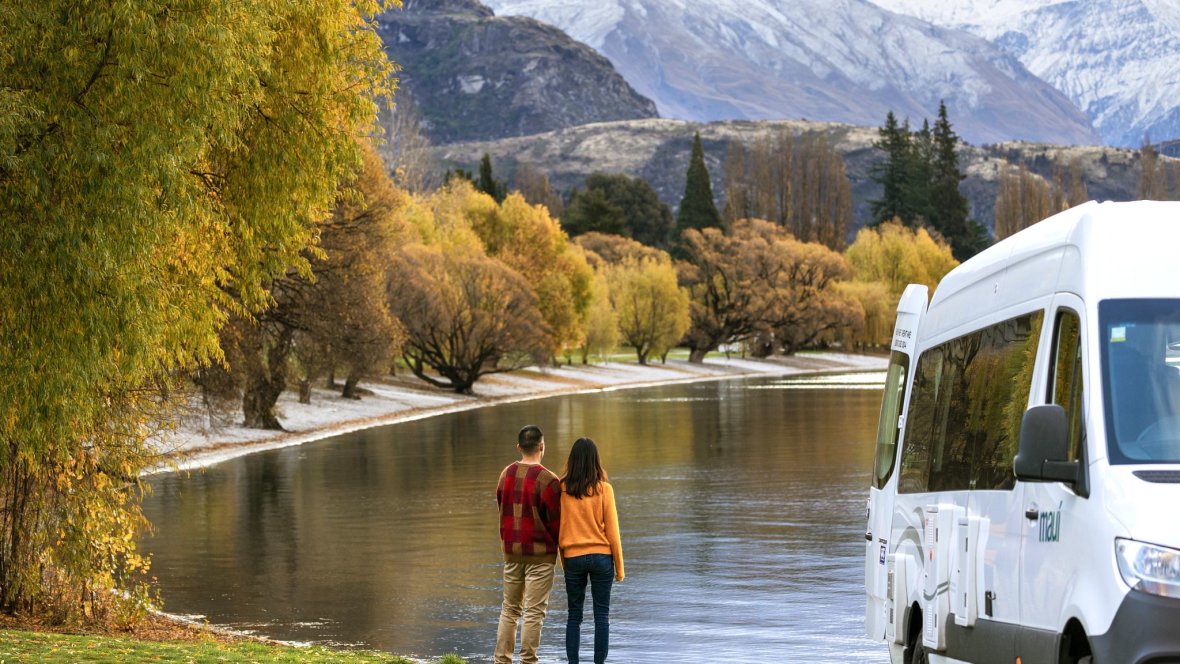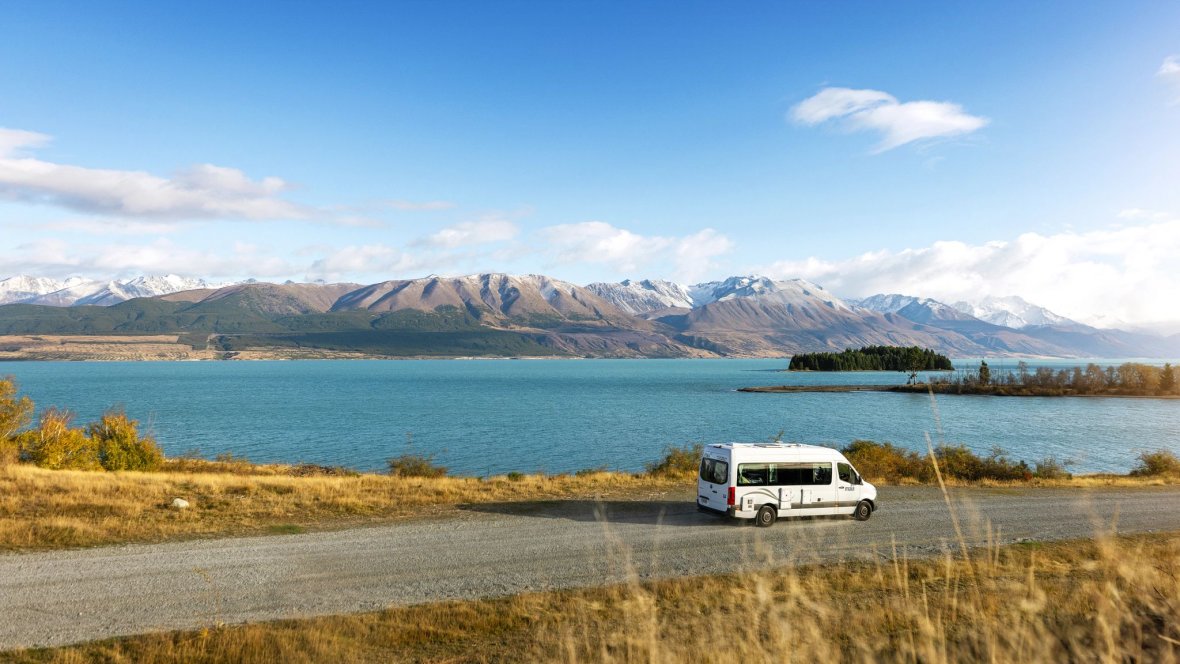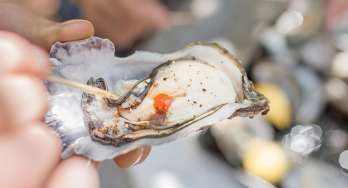Where is the Otago Peninsula?
The Otago Peninsula sits on the southeastern edge of the South Island, just a short drive from central Dunedin. It stretches out into the Pacific Ocean, forming one side of the natural harbour that gives Dunedin its unique coastal setting.
Getting there is simple – it’s around a 20-minute drive from Dunedin’s city centre, making it an easy addition to any South Island road trip. The route is well suited to campervans, with winding coastal roads that offer plenty of places to pull over and enjoy the views.
The scenic drive: A campervan dream
One of the best ways to take in the Otago Peninsula is simply to drive it. The roads here hug the coastline and twist through hills, offering views that change with every bend.
Both Highcliff Road and Portobello Road are popular options, and each has its own charm. Highcliff winds along the ridge with wide-open views, while Portobello traces the water’s edge with quiet bays and birdlife along the way.
There are plenty of spots to pull over for a picnic or a photo, and you’ll find camper-friendly places to stop for a break without having to rush. It’s the kind of drive where you’ll want to keep your camera handy – and take your time.

Must-visit attractions
The Otago Peninsula is packed with places that are worth more than just a quick look. Whether you're into wildlife, heritage buildings, or wide open beaches, there's plenty to explore – and most spots are easy to reach with a campervan. Here are a few favourites that offer something for both kids and adults.
Larnach Castle
Perched on a hill with views across the harbour, Larnach Castle is New Zealand’s only castle. Families can wander through the historic rooms, explore the gardens, or stop for afternoon tea in the café. It’s a good mix of history and fresh air – plus, kids love the tower climb.
Royal Albatross Centre
The Royal Albatross Centre is the only place in the world where you can see these huge seabirds nesting on a mainland site. The guided tours are informative without being too heavy, and there’s plenty to keep kids interested – from interactive displays to the chance of spotting seals or penguins nearby.
Penguin Place
A must-see while you’re exploring the Otago Peninsula, Penguin Place is a conservation project focused on protecting the endangered yellow-eyed penguin. The guided tours take you through purpose-built hides and tunnels, which makes it easier to see the penguins without disturbing them. It’s a rare chance to see wildlife up close in a way that’s respectful and well managed.
Sandfly Bay
Down a steep path and across sand dunes, Sandfly Bay is worth the effort. It’s one of the more remote beaches on the peninsula, known for sea lion sightings and quiet walking tracks. It’s not the easiest place to access, which makes it ideal if you're travelling by campervan and keen to explore spots off the main tourist trail.
Otago Peninsula EcoTours
Keen to learn more about this special part of New Zealand? Otago Peninsula EcoTours offers small group wildlife tours that explore the coastline and its marine life. The guides are knowledgeable and the pace is relaxed, with options for half-day or full-day tours. It’s a good way to cover more ground if you're short on time but still want to see the peninsula’s wild side.
Outdoor activities and adventures
When you’re exploring the Otago Peninsula by campervan, the outdoors is never far away – and that’s part of the charm. This is the kind of place where you can spend the morning on the water, take a walk in the afternoon, and still be back in time for dinner with a view.
Kayaking is a great option around Portobello and Broad Bay, where the sheltered harbour keeps the water relatively calm. It’s a low-key way to see the coastline, and you’ll often spot marine life along the way. If you’ve got kids with you, this can be a fun and gentle intro to paddling – just check the conditions and tide times before you head out.
Walking tracks are dotted all over the peninsula, ranging from short walks to more rugged trails. The Allans Beach track is an easy stroll through farmland and bush to a quiet beach that often has fur seals sunning themselves on the sand. Victory Beach is another great choice – it’s flat and family-friendly, with the chance to see sea lions and native birdlife. If you’re up for a bit of a climb, Lovers Leap offers dramatic cliff-top views and a good leg stretch.
Cycling is also a fun way to explore the peninsula. The roads around here are quieter than most and wind through small bays, farmland, and coastal villages – perfect for a laid-back ride with a few scenic stops along the way. There are plenty of bike hire providers in Dunedin to help get you on the road safely and easily.
Cultural & local flavours
The Otago Peninsula isn’t just about wildlife and walks – there’s a strong creative streak running through it too, especially in and around Portobello village. This small harbour-side community is a great place to slow down, grab a coffee, and browse a few local galleries or gift shops. There’s a cosy feel to the village, and it’s well set up for visitors, with campervan parking available near the main street and public toilets close by.
Cafes in Portobello are a good spot to refuel after a morning walk or drive. You’ll find simple, fresh fare on most menus – think local seafood, home baking, and barista coffee. Many places have outdoor seating too, which makes it easy if you’ve got kids in tow or just want to sit and enjoy the harbour views.
If your visit falls on a Saturday, it’s worth heading into town for the Otago Farmers Market. It’s about a 25-minute drive from Portobello, but well worth it for fresh produce, artisan snacks, and a taste of Dunedin’s food scene. There’s usually live music and a laid-back crowd, plus plenty of food truck options if you’re hungry.
You’ll also spot small craft stores and roadside stalls dotted along the peninsula – perfect for picking up a few handmade souvenirs or treats to enjoy back at your campervan. Whether you're after a casual lunch or just a decent coffee with a view, it’s easy to find a spot that fits the mood.
Wildlife watching tips
The Otago Peninsula is one of the best places in Aotearoa to see wildlife up close – but a bit of timing and know-how can make all the difference. Many of the local species are most active at certain times of day, and knowing when (and how) to look gives you a much better chance of spotting them.
Yellow-eyed penguins usually return to shore in the late afternoon or early evening, especially around beaches like Sandfly Bay and Victory Beach. Keep a respectful distance and avoid getting between them and the water.
For sea lions and fur seals, mornings and evenings tend to be good times, and they’re often found lazing on quieter stretches of sand. If you’re hoping to see albatross in flight, head to Taiaroa Head when the wind picks up – they rely on it to get airborne, and strong breezes make for better viewing conditions.
Ethical viewing is really important here, and most wildlife experiences on the peninsula are built around protecting the animals as much as showcasing them. Stick to marked tracks, use designated viewing platforms, and keep noise to a minimum – especially if you’re travelling with kids. Never try to feed or approach the animals, and avoid using flash photography.
It’s also worth packing a pair of binoculars and a camera with a zoom lens if you have one. Much of the wildlife can be spotted from a distance, and the less you disturb them, the better the experience for everyone.
How the Otago Peninsula complements a Dunedin itinerary
One of the perks of visiting the Otago Peninsula is how easy it is to pair with a day or two in Dunedin. The city and the peninsula feel quite different, but together they make for a well-rounded trip – especially if you’re travelling by campervan and want a mix of nature, culture, and history without covering big distances.
In town, you’ll find a handful of spots that are well worth adding to your list. The Dunedin Railway Station is one of the most photographed buildings in the country – partly for its architecture, and partly because it marks the start of some great rail journeys.
If you’re after something a bit more modern, the Street Art Trail winds through the city centre and features large-scale murals by local and international artists. It’s easy to explore on foot and makes a fun scavenger hunt-style activity for families.
For a rainy day option or something more hands-on, the Otago Museum has interactive exhibits and a popular science centre that’s great for kids. It’s also free to enter, which makes it a good budget-friendly option.
Because the city and the peninsula are so close together, it’s simple to set up base at a local holiday park and spend your days mixing urban and coastal experiences. You get the best of both worlds – and very little time spent driving between them.

Tips for exploring the Otago Peninsula by campervan
Travelling the Otago Peninsula by campervan is one of the easiest and most rewarding ways to explore the area. The roads, towns, and scenic spots are all nicely spaced out, making it a relaxed drive with plenty of chances to stop and explore. Here are a few practical tips to help you plan your visit:
-
Where to stay
Portobello Village Tourist Park is a popular choice with well-kept facilities and a peaceful location close to cafes and walking tracks.
Hoopers Inlet Campground offers a basic but scenic option for those looking for a free camping site – it’s suitable for self-contained campervans.
You’ll also find other options closer to the city, and our guide to the best campsites and holiday parks in Dunedin is a good place to start.
-
Freedom camping and dump stations
Make sure to check local rules around freedom camping, as the Otago Peninsula has specific zones where it’s permitted. Stick to designated areas and always dispose of waste responsibly at dump stations – many are clearly signposted and available at most holiday parks or visitor centres.
-
Driving tips
The roads are scenic but can be narrow and windy in places, especially along Highcliff Road. Take it slow, allow extra time, and keep an eye on fuel levels – petrol stations are limited along the peninsula, so it’s best to top up in Dunedin before heading out.
-
Best time to hike
Spring (September to November) and summer (December to February) are ideal for walking tracks and wildlife spotting. These seasons bring mild weather, longer daylight hours, and better chances of seeing penguins, seals, and albatross. To avoid crowds, aim for early mornings or later afternoons, especially at popular beaches and lookouts.
-
What to pack
Weather can shift quickly, so bring layers, a good rain jacket, and sturdy walking shoes. A daypack with water, snacks, sunscreen, and a hat will go a long way, especially if you’re heading out on the trails or to the beach.
-
Leave no trace
Help protect the peninsula’s unique environment by sticking to paths, taking rubbish with you, and keeping a respectful distance from wildlife.
Start planning your Otago escape
The Otago Peninsula is full of reasons to take the long way round – quiet roads, wildlife encounters, and the kind of places that make you want to stay a little longer. With a maui campervan, it’s easy to take it all in at your own pace, with the freedom to stop wherever the view looks good or the penguins come ashore.
Ready to hit the road? Book your maui campervan online today and start planning your South Island getaway.
FAQ
Is the Otago Peninsula worth visiting?
Absolutely. The Otago Peninsula is one of the best places in New Zealand to combine coastal scenery with rare wildlife, history, and small-town charm – all within easy reach of Dunedin. From albatross colonies to historic buildings like Larnach Castle, it offers a laid-back experience that’s ideal for campervan travellers.
Where to see seals on Otago Peninsula?
Seals can often be spotted on the beaches around the peninsula, especially at Allans Beach, Victory Beach, and Sandfly Bay. They usually haul out to rest during the day, so keep a respectful distance and enjoy watching them from afar.
Where to see penguins on Otago Peninsula?
The peninsula is one of the few places where you can see the endangered yellow-eyed penguin in the wild. Penguin Place offers guided conservation tours that make it easier (and more ethical) to spot them. You may also see penguins coming ashore at dusk around beaches like Sandfly Bay, especially during breeding season.
What is Otago known for?
Otago is known for its dramatic coastline, colonial history, and unique wildlife. The region blends Scottish heritage with Māori culture, and offers everything from street art in Dunedin to remote beaches and native species like albatross, seals, and penguins. It’s also home to one of the country’s most scenic rail stations – the Dunedin Railway Station – and the wider region includes Central Otago’s wineries and cycling trails.
.jpg)


